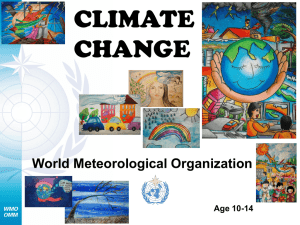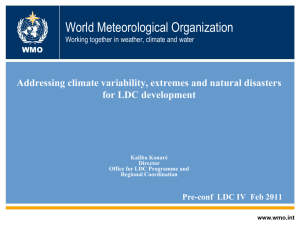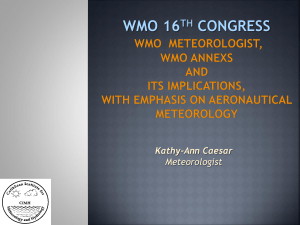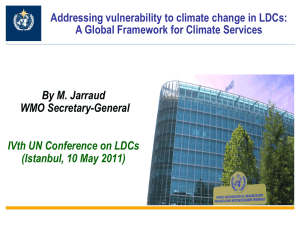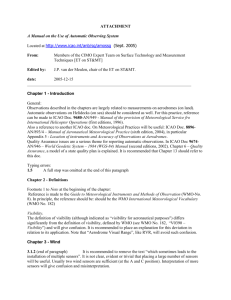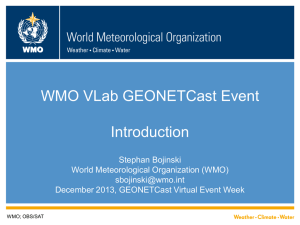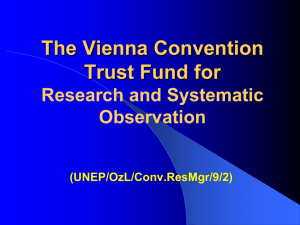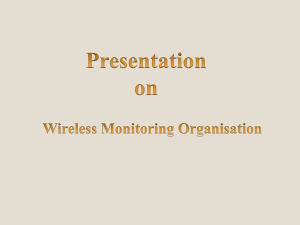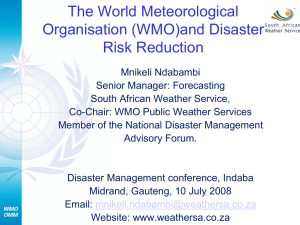World Meteorological Organization Working together in weather
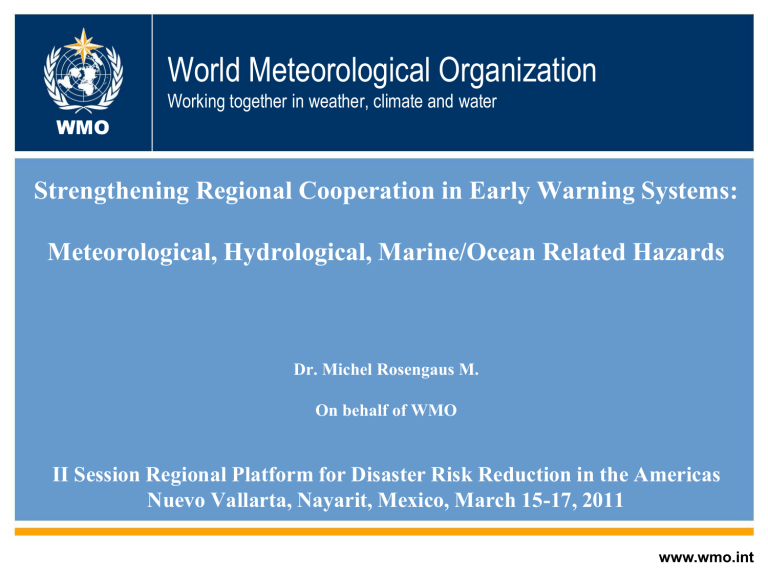
World Meteorological Organization
Working together in weather, climate and water
WMO
Strengthening Regional Cooperation in Early Warning Systems:
Meteorological, Hydrological, Marine/Ocean Related Hazards
Dr. Michel Rosengaus M.
On behalf of WMO
II Session Regional Platform for Disaster Risk Reduction in the Americas
Nuevo Vallarta, Nayarit, Mexico, March 15-17, 2011 www.wmo.int
Background
• What is the WMO ?
• The W orld M eteorological O rganization is a technical, specialized organism of the United Nations, in charge of
Meteorology, Water and Climate. It has 188 members (states and territories), which are usually represented by their N ational
M eteorological and H ydrological S ervices
• Why should de DRR community be interested in the WMO and its members (the NMHS’s)?
• Besides the obvious reasons (hydromet hazards tracking, analysis and forecasting), because, at the global and regional levels, it provides an operational framework on which sustainable EWS’s can be built; many of its members have longer than 100 years of non-stop operation.
Background
• In some sense, the WMO as a whole, has the architecture of a
Global EWS, and its 6 Regional Associations, of Regional EWS:
• Example 1: Global N umerical W eather P rediction (NWP) availability to everyone is organized by WMO
• Example 2: (Almost) Global Satellite Image coverage and availability to everyone is organized by WMO
• Example 3: R egional S pecialized M eteorological C enters (as is the National Hurricane Center in Miami) in it’s international duties are coordinated by the WMO
• Example 4: IPCC main office is inside the WMO building in
Geneve, Switzerland
Early Warning Systems Require Coordination
Across Many Levels and Agencies
National to local disaster risk reduction plans, legislation and coordination mechanisms
1 2
3 4
Complex interactions required
WMO
The hazard monitoring box The response box
Meteorological,
Hydrological,
Marine and
Climate
Services
Analysis,
Forecasts,
Data
Vulnerability,
Exposure,
Requirements
Disaster
Risk
Reduction and
Management
(DRR & DRM)
(may be different agencies)
(Civil Defense/Protection and probably others)
Two boxes usually belong to different Ministries
Global
Complex interactions required
(the original world)
The response box
Global
Regional
National
State/Province
Municipality
Hydromet, Marine, Climate
Regional
National
State/Province
Municipality
DRR and DRM
Complex interactions happening
(the new world)
The response box
Global Global
Regional
National
State/Province
Municipality
Hydromet, Marine, Climate
Regional
National
State/Province
Municipality
DRR and DRM
Hazard
Analysis and
Mapping
Heavy Precipitation and flood mapping
Need for historical and real time data
Statistical analysis tools climate forecasts and trend analysis
Specific example interactions
Exposure and
Vulnerability
Impacts:
population density
agricultural land
urban grid
Infrastructure
Businesses
Need for Socioeconomic impacts data and analysis tools
Potential
Loss
Estimates
Number of lives at risk
$ at risk
Destruction of buildings and infrastructure
Reduction in crop yields
Business interruption
Need for risk assessment tools combining hazard, asset and exposure information
10 Basic principles for effective
Early Warning Systems
1.
Political recognition of the benefits of EWS along with effective planning, legislation and budgeting
2.
Effective EWS are built upon four components :
(i)) hazard detection, monitoring and forecasting;
(ii) analyzing risks and incorporation of risk information in emergency planning and warnings;
(iii) disseminating timely and “authoritative” warnings with clarity on the responsibilities and mandate for issuance of warnings;
(iv) community emergency planning and preparedness and the ability to activate emergency plans to prepare and respond
3.
Roles and responsibilities of all EWS stakeholders and their collaboration mechanisms clearly defined and documented
4.
Capacities aligned with resources across national to local levels
(sustainability)
5.
Hazard, exposure and vulnerability information are used to carryout risk assessments at different levels
10 Basic principles for effective Early
Warning System (Continued)
6.
Clear, consistent and actionable hazard warnings , with risk information and issued from a single recognized authoritative source
7.
Timely, reliable, redundant and sustainable warning dissemination mechanisms
8.
Emergency response plans targeted to the individual needs of the vulnerable communities, authorities and emergency responders
9.
Regular training and education programmes in risk awareness and emergency response actions
10. Effective feedback mechanisms throughout levels of the
EWS for system improvement over time
Initiatives and pilot projects in:
Central America and Mexico
The Caribbean
Early Warning Systems with Multi-Hazard
Approach Pilot Project – Central America
• Pilot Countries:
– Costa Rica (World Bank Funded)
– El Salvador (NOAA – USAID funded)
– Mexico (Government and NOAA – USAID funded)
• National multi-agency cooperation
(Met/Hydro/DRM)
• Multi-level (Regional, National, Local)
• Focus: Flash Flood-Riverine Flood Warning Systems
• Partners: WMO, NOAA-NWS, UNDP, World Bank
The Caribbean
Goal
Strengthening meteorological, hydrological and climate services at national and regional levels to support risk assessment and Multi-
Hazard Early Warning Systems
Focus sectors: DRM, Agriculture and Food Security,
Water Resource Management, Planning and
Development Sectors
Where ?
Strengthened coordination and cooperation across British, French,
Dutch and Spanish Speaking countries and territories
Antigua and Barbuda, Aruba, the Bahamas, Barbados, Bermudas, the British
Caribbean Territories, the Caribbean Netherlands, Cuba, Curacao, Dominica, the
Dominican Republic, the French West Indies, Grenada, Guyana, Haiti, Jamaica,
Saint Kitts and Nevis, Saint Lucia, Saint-Marteen, Saint Vincent and the
Grenadines, and Trinidad and Tobago also including Beliz and Surinam
Who?
Key Stakeholders in the region have been engaged
National:
• Beneficiaries:
• National Meteorological and Hydrological Services (NMHS) and Disaster Risk
Management (DRM) Agencies and other key ministries of the beneficiary countries.
• Other ministries, specifically, finance and planning, agriculture, water resource management and coastal zone management
• Contributing Countries: USA, Finland, France, Canada, Spain, others (TBD)
Regional:
• Regional centers and agencies of CARICOM: CDEMA, CMO and its CIMH;
• WMO RA IV and its DRR and Hydrology Task Teams, WMO RA IV Hurricane
Committee, the WMO RSMC – Miami Hurricane Center
• Regional agencies and platforms: ACS, OAS, Caribbean Development Bank (CDB)
International and donors
:
• UN and International Agencies: WMO, UNDP, UNESCO-IOC, etc.
• Bi-lat donors and development banks: IADB, World Bank, USAID/OFDA, Canada
(CIDA), Finland (MFA), Spain (ACE), Japan (JICA), others (TBD) etc.
How?
Long-term Capacity Development (8 years) with phased project management (2-yr cycle)
• 2010-2011
:
Development of programmatic and technical aspects
Long-term capacity development and phase-I project priorities
• 2011
:
– Phase-I (multi-component) project implementation plan and project governance
– Institutional mapping and partnerships for implementation(national and regional)
– Resource mobilisation strategy and coordination with the donors
– Regional mechanisms for multi-stakeholder coordination, sharing progress, experiences, monitoring and evaluation
• 2012
:
Phase-I Project (multi-component) to be Launched
Roadmap for the project design to strengthen Caribbean
Risk Assessment and MHEWS capacities
Consultations, Major Milestones and Timeline
MHEWS
Training
Workshop
–
Consultants’ missions in the region and assessment of all assessment and projects
MHEWS
Technical
Cooperation
Workshop
Consultation
Costa Rica Barbados Cayman Is.
March
2010
June – September
2010
November
2010
November
2010
MH
Forecasting meeting
Hurricane
Committee -
Cayman
Islands
7 March 2011
Warning
Communicati on/CAP
PWS workshop -
Miami
March/April
2011
Official
Regional
Meeting to endorse
Phase I project proposal
2010 2011 2012 http://www.wmo.int/pages/prog/d rr/events/MHEWSCostaRica/inde x_en.html
http://www.wmo.int/pages/ prog/drr/events/Barbados/ index_en.html
Consultation
Jamaica
December
2010
Develop overall plan, phase I project proposals, implementation plan, resource mobilizations and identification of forums for on-going regional dialogue with Members, development partners and donors
Phase I
Project
Launch
Outcomes to Date:
Reference document produced for programme and project development …
• National Roster: Directors and experts from Met and Hydro services, DRM, Planning, Agriculture and food security and water resource management sector
– Hydro network needs to be mapped in more details )
– Agriculture, water resource management sectors need to be mapped further
• Regional Roster: Regional agencies supporting DRM
• Mapping of assessments and projects: in the region and opportunities for leveraging
• Relationship of Met/Hydro/DRM agencies countries/territories mapped
• Identification of capacities, remaining gaps and needs not addressed through existing projects
• Priorities for long-term capacity development (national and regional)
• Priorities for phase-I project (multi-component)
Priority Hazards
• Overall priority hazards for both subregions:
Tropical Cyclones, Storm Surge, High Waves,
Flash and Riverine Flooding, Heavy Precipitation,
Drought , Land/Mud Slides and Volcanic Eruption
• Specific hazard priories vary by country/territory based on geography, orography, seasonal patters, etc.
Areas requiring long-term development as identified from extensive consultations
1) Establishment of policies, legislation and institutional arrangements with clarification of role of national meteorological and hydrological services within different arrangements - Partnerships
2) Provision of Meteorological, Hydrological and Marine and Coastal hazard databases (statistical and real-time), metadata and hazard analysis to support risk assessment
3) Service Delivery approach within the NMHS to support DRM and economic sectors
– QMS and SOPs developed between NMHS and other DRM and sectoral stakeholders (institutionalizations)
– Application of WMO service delivery framework
4) Strengthened operational meteorological, hydrological, marine/coastal and climate forecast products and training to support target serctors ( national and regional components)
5) Coordinated Multi-Hazards early warning systems in the region
Phase-I Project Components
• Component 1: Policy, legislative and clarification of role and mandates of the NMHS in support of DRM
• Component 2: Strengthening of forecasting capacities for other priority hazards (nowcasting to longer-term)
– Strengthening of regional operational products and services
– Training
• Component 3: Warning dissemination, communication, and development of CAP
• Component 4: Initiation of QMS and SOPs of NMS and
DRM agencies – with a service delivery approach
• Component 5: Pilot on (data rescue, data management) observational interoperability, data exchange and hazard analysis within the PPCR Regional Programme
Thank You
For more information, please contact WMO:
Maryam Golnaraghi, Ph.D.
Chief of Disaster Risk Reduction Programme
World Meteorological Organization
Tel. 41.22.730.8006
Fax. 41.22.730.8023
Email. MGolnaraghi@WMO.int
Presenter:
Michel Rosengaus, Sc.D.
michel.rosengaus@conagua.gob.mx
mickros@prodigy.net.mx
Tel. 52.55.2636.4600 x3410
